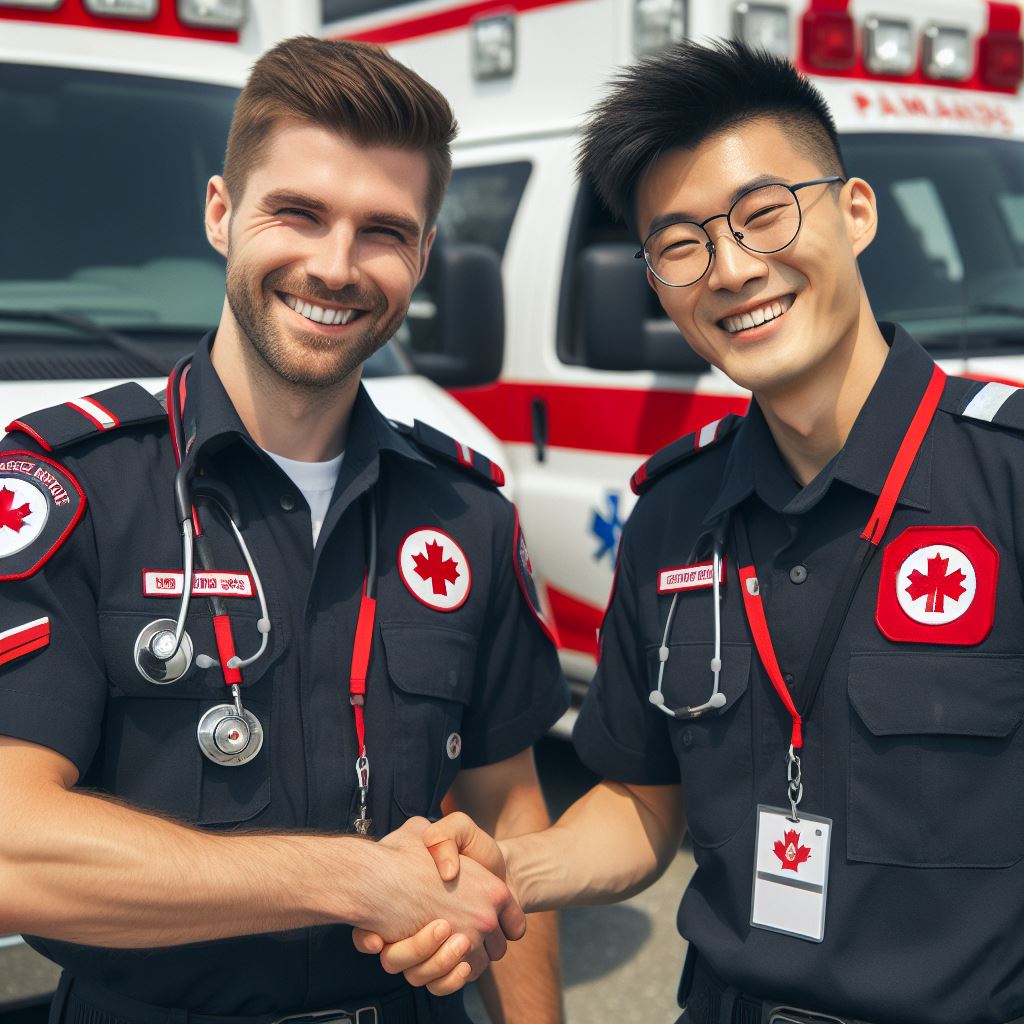Paramedic vs EMT: Understanding the Differences
Last Updated on January 28, 2024
Introduction
Emergency Medical Services (EMS) play a pivotal role in saving lives during critical situations.
They are the frontline heroes, offering immediate care in crises.
In this blog, we delve into a crucial aspect of EMS: the distinctions between paramedics and EMTs.
These dedicated professionals are the backbone of emergency healthcare, yet their roles and training differ significantly.
Understanding these disparities is vital for appreciating the diverse skills and responsibilities within the EMS field.
Paramedics possess advanced training, allowing them to administer medications and perform advanced medical procedures.
On the other hand, Emergency Medical Technicians (EMTs) are skilled in basic emergency medical care, focusing on stabilizing patients and transporting them to medical facilities.
Differentiating between these roles is more than just semantics; it defines the level of care provided in emergencies.
Highlighting these differences not only honors their expertise but also educates the public on who to expect in varying emergency situations.
Join us as we explore the unique roles of paramedics and EMTs, shedding light on their indispensable contributions to our communities’ well-being.
Definition and Role of a Paramedic
What is a Paramedic?
Paramedics are highly trained emergency medical professionals who provide advanced life support.
Their primary role involves delivering critical medical care at the scene of emergencies.
Level of Training and Education
Becoming a paramedic requires rigorous training, typically a two-year program at a college or technical institute.
This education encompasses various medical disciplines, from anatomy and physiology to advanced life-saving procedures.
Advanced Skills and Procedures
Paramedics are skilled in performing complex medical interventions such as endotracheal intubation, administering intravenous medications, and interpreting electrocardiograms.
They can also deliver cardiac monitoring, defibrillation, and manage various trauma and medical emergencies.
Situations Requiring Paramedics
Paramedics are called to a wide array of critical situations, from severe accidents to cardiac arrests.
For instance, in a serious car crash with critical injuries, paramedics provide immediate advanced medical care on-site, stabilizing patients before transportation to a hospital.
Paramedics hold a crucial place in the Emergency Medical Services (EMS) system, working alongside emergency medical technicians (EMTs) to provide comprehensive and immediate medical assistance.
Their advanced training and skills enable them to make critical decisions and perform invasive procedures, ensuring patients receive essential care during emergencies.
Paramedics are needed in cases of cardiac arrest, severe trauma, respiratory distress, and overdose emergencies.
Read: Navigating Pharmacy Ethics in Canada
Definition and Role of an EMT
An Emergency Medical Technician (EMT) is a medical professional who provides pre-hospital care to individuals in emergency situations.
They play a crucial role within the Emergency Medical Services (EMS) system.
In order to become an EMT, individuals must undergo extensive training and obtain certification.
This training typically includes coursework in anatomy, physiology, and basic medical procedures.
Once certified, EMTs are authorized to perform a range of medical interventions within their scope of practice.
They can administer CPR, apply splints, and provide basic life support to patients.
EMTs are typically involved in a variety of emergency situations.
For example, they often respond to car accidents, where they assess patients’ injuries and provide immediate medical assistance.
In addition to accidents, EMTs are frequently called to the scene of medical emergencies, such as heart attacks or strokes.
They are trained to stabilize patients and provide them with the necessary care until they can be transported to a hospital.
EMTs can also be found in settings such as sporting events or concerts where large crowds gather.
In these situations, they are responsible for providing immediate medical attention to anyone who becomes injured or falls ill.
One of the primary responsibilities of an EMT is to assess a patient’s condition and make critical decisions regarding their treatment.
EMTs in Emergency Care: Skills, Limitations, and Vital Role
They must be able to think quickly and prioritize their actions in order to provide the best possible care.
Furthermore, EMTs must possess excellent communication skills.
They must effectively communicate with patients, their families, and other healthcare professionals in order to gather important information and provide updates on the patient’s status.
In some cases, EMTs may need to administer medications to patients, such as epinephrine for severe allergic reactions.
However, the specific interventions they are allowed to perform can vary depending on state regulations and the level of their certification.
It is important to note that while EMTs are highly trained, they are not able to provide the same level of care as a paramedic.
This is because paramedics undergo additional training and have a wider scope of practice.
In fact, EMTs play a critical role in the EMS system, providing immediate medical care to individuals in emergency situations.
Their training and certification allow them to perform a variety of medical interventions, making them essential members of the healthcare team.
Read: The Role of Tech in Pharmacy Practice
Education and Training Differences
Comparing the Level of Education and Training
Paramedics and EMTs have different levels of education and training requirements.
Paramedics undergo more extensive training in comparison to EMTs.
- Paramedics require more advanced education and training than EMTs.
- EMTs typically complete a certificate or diploma program, while paramedics often have an associate’s or bachelor’s degree.
- Paramedic programs have more rigorous coursework and clinical training.
- EMTs receive a basic level of education and training.
Curriculum and Coursework Covered in Paramedic and EMT Programs
The curriculum and coursework covered in paramedic and EMT programs differ based on the level of training required for each profession.
- Paramedic programs cover advanced topics such as anatomy, physiology, pharmacology, and advanced life support.
- EMT programs focus on basic medical skills, emergency response, and patient assessment.
- Paramedic coursework includes advanced interventions and critical care procedures.
- EMT coursework emphasizes basic life support techniques and emergency medical skills.
Clinical Experience and Hands-On Training
Both paramedics and EMTs require clinical experience and hands-on training to develop their skills in a real-world context.
- Paramedics undergo more extensive clinical experience, often working in hospital emergency departments and on ambulance rotations.
- EMTs also gain hands-on experience through internships and ambulance ride-alongs.
- Paramedics receive training in advanced medical procedures, such as intubation, intravenous therapy, and administering medications.
- EMTs focus on basic life support procedures, including CPR, wound management, and splinting.
Additional Certifications or Specialization Options
Paramedics and EMTs have opportunities for additional certifications and specialization to enhance their skills and career prospects.
- Paramedics can pursue certifications in critical care, flight paramedicine, and pediatric advanced life support.
- EMTs can specialize in areas such as wilderness medicine, tactical emergency medical support, or community paramedicine.
- Paramedics have a wider range of advanced certifications available to them compared to EMTs.
- EMTs can enhance their skills through continuing education courses and workshops.
In short, paramedics and EMTs differ in the level of education, training, curriculum, and hands-on experience they undergo.
Paramedics generally require more advanced education and training, covering a broader range of medical knowledge and procedures.
Both professions play crucial roles in emergency medical care and have opportunities for additional certifications and specialization.
It is essential to understand the differences between paramedics and EMTs to fully appreciate their expertise and the level of care they provide in emergency situations.
Read: A Day in the Life of a Canadian Paramedic

Responsibilities and Job Settings
In the field of emergency medical services (EMS), both paramedics and Emergency Medical Technicians (EMTs) play crucial roles in providing life-saving care to patients.
While their roles may overlap in certain situations, there are distinct differences in their responsibilities and job settings.
Responsibilities Assigned to Paramedics
Paramedics are highly skilled healthcare professionals who are capable of providing advanced medical care to patients.
They are trained to perform a wide range of procedures and interventions.
In hospital settings, paramedics often work in emergency rooms, intensive care units, or critical care units. Their responsibilities may include:
- Triaging and stabilizing critically ill or injured patients
- Administering medications, including intravenous drugs
- Performing advanced medical procedures, such as intubation and cardiac monitoring
- Assisting with emergency surgeries and procedures
- Coordinating with other healthcare professionals and providing input on patient care plans
Within ambulance services, paramedics typically work as part of a team, responding to emergency calls and providing on-site medical care.
Their responsibilities may include:
- Assessing patients’ conditions and providing immediate medical interventions
- Administering medications and managing IV lines
- Performing advanced cardiac life support (ACLS) interventions
- Providing ongoing care and monitoring during transportation to the hospital
- Documenting patient information and communicating with hospital staff
Paramedics may also be part of specialized teams, such as helicopter or tactical EMS units, where they provide advanced medical support in unique settings.
Work Environments for EMTs
EMTs, on the other hand, focus on providing basic medical care and transportation to patients.
They are generally the first point of contact for patients in emergency situations.
EMTs can be found working in various environments, including:
- Fire departments: Many fire departments employ EMTs to respond to medical emergencies alongside firefighters.
- Private ambulance companies: EMTs are commonly employed by private ambulance companies that provide emergency transportation services.
- Emergency rooms: Some EMTs work directly in emergency rooms, assisting with patient intake and providing initial assessments.
Differences in Responsibilities and Job Settings
While there are many similarities between the responsibilities of paramedics and EMTs, there are some notable differences.
Paramedics have a more comprehensive scope of practice and can perform advanced medical procedures that EMTs are not trained for.
They often work in hospital settings, where they are involved in more complex patient care scenarios.
EMTs, on the other hand, focus on providing basic life support and transportation.
They frequently work in pre-hospital settings and may be part of rapid response teams in fire departments or private ambulance companies.
It is important to note that the specific responsibilities and job settings of paramedics and EMTs can vary depending on local regulations and protocols.
Additionally, both paramedics and EMTs constantly undergo training to stay updated with the latest advancements in emergency medicine.
In essence, paramedics and EMTs play critical roles in the EMS field, with differing responsibilities and job settings.
Their collaboration ensures that patients receive the appropriate level of care during medical emergencies.
Read: Continuing Education for Canadian Med Techs
Explore Further: Public Health Outreach: Effective Strategies
Career Advancement Opportunities
Potential Career Paths for Paramedics
- Paramedics can pursue careers as flight paramedics, working on helicopters or airplanes to provide emergency medical care.
- They can also work in hospitals, serving as emergency room paramedics or working in specialized units such as cardiac or pediatric care.
- Some paramedics choose to work as educators, training future paramedics and EMTs.
- Paramedics can also work in research or public health organizations, contributing to the development of new protocols and initiatives.
Specializations and Advanced Certifications for Paramedics
- Paramedics can specialize in areas such as trauma, cardiac care, neonatal care, or critical care.
- They can also obtain advanced certifications in skills like advanced cardiovascular life support (ACLS) or pediatric advanced life support (PALS).
- By becoming certified as a tactical paramedic, they can work alongside law enforcement in tactical situations.
- Paramedics can pursue a career in disaster response, joining specialized teams that provide medical support during emergencies.
Using Experience as a Stepping Stone from EMT to Paramedic
For EMTs, working in the field can serve as valuable experience before pursuing paramedic training.
EMTs can gain a deeper understanding of emergency healthcare and develop important skills such as patient assessment and basic life support.
This experience can give them a foundation to build upon when undertaking paramedic training.
Transitioning from EMT to paramedic allows individuals to take on more advanced responsibilities in patient care and treatment.
Additional Educational and Professional Development Options
- Both paramedics and EMTs can benefit from pursuing higher education degrees in fields such as emergency medical services management or public health.
- Continuing education courses and workshops also provide opportunities to enhance skills and stay up-to-date with advancements in the field.
- Advanced degrees such as a Master’s in Emergency Medical Services or a Doctorate in Emergency Medicine can open doors for leadership positions or research careers.
- Joining professional associations and organizations provides networking opportunities and access to resources for career growth.
In general, the career advancement opportunities for paramedics are diverse and rewarding.
From specialized positions to advanced certifications, paramedics have the chance to specialize in areas that align with their interests and passions.
EMTs can use their experience as a stepping stone to become paramedics, expanding their scope of practice and taking on more challenging roles.
Both paramedics and EMTs can pursue additional education, certifications, and professional development to further enhance their knowledge and skills.
The field of emergency medical services offers a range of possibilities for growth and advancement, ensuring a fulfilling and dynamic career for those in the profession.
Conclusion
It is crucial to understand the main differences between paramedics and EMTs.
Paramedics possess advanced training and can perform a wider range of medical procedures, whereas EMTs focus on basic emergency care.
Both professions play a vital role in the EMS system, providing immediate medical attention and saving countless lives.
The importance of paramedics and EMTs cannot be overstated.
Their swift response and ability to make critical decisions in high-pressure situations are invaluable.
Paramedics bring an advanced level of expertise to the field, administering medications, performing advanced airway management, and even delivering babies.
On the other hand, EMTs serve as the first line of defense, stabilizing patients, managing bleeding, and providing essential life support.
Both paramedics and EMTs work collaboratively as a team to ensure the best possible outcomes for patients.
Their combined efforts, knowledge, and skills significantly improve the chances of survival during emergencies.
The EMS system relies heavily on these professionals to respond promptly, assess the situation accurately, and provide appropriate care, thereby reducing morbidity and mortality rates.
If you are considering a career in emergency medical services, it is crucial to explore the available options.
Whether you choose to become a paramedic or an EMT, you will undoubtedly make a difference in people’s lives every day.
The medical field requires dedicated individuals willing to work in high-stress environments and provide critical care when it matters the most.
All in all, paramedics and EMTs are the backbone of the EMS system.
They are essential for ensuring swift and effective emergency medical care.
Consider exploring these rewarding careers and joining the noble profession of saving lives.


